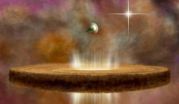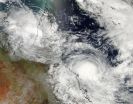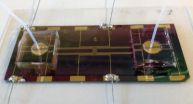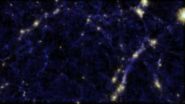(Press-News.org) The Orion Nebula is home to hundreds of young stars and even younger protostars known as proplyds. Many of these nascent systems will go on to develop planets, while others will have their planet-forming dust and gas blasted away by the fierce ultraviolet radiation emitted by massive O-type stars that lurk nearby.
A team of astronomers from Canada and the United States has used the Atacama Large Millimeter/submillimeter Array (ALMA) to study the often deadly relationship between highly luminous O-type stars and nearby protostars in the Orion Nebula. Their data reveal that protostars within 0.1 light-years (about 600 billion miles) of an O-type star are doomed to have their cocoons of dust and gas stripped away in just a few millions years, much faster than planets are able to form.
"O-type stars, which are really monsters compared to our Sun, emit tremendous amounts of ultraviolet radiation and this can play havoc during the development of young planetary systems," remarked Rita Mann, an astronomer with the National Research Council of Canada in Victoria, and lead author on a paper in the Astrophysical Journal. "Using ALMA, we looked at dozens of embryonic stars with planet-forming potential and, for the first time, found clear indications where protoplanetary disks simply vanished under the intense glow of a neighboring massive star."
Many, if not all, Sun-like stars are born in crowded stellar nurseries similar to the Orion Nebula. Over the course of just a few million years, grains of dust and reservoirs of gas combine into larger, denser bodies. Left relatively undisturbed, these systems will eventually evolve into fully fledged star systems, with planets -- large and small -- and ultimately drift away to become part of the galactic stellar population.
Astronomers believe that massive yet short-lived stars in and around large interstellar clouds are essential for this ongoing process of star formation. At the end of their lives, massive stars explode as supernovas, seeding the surrounding area with dust and heavy elements that will get taken up in the next generation of stars. These explosions also provide the kick necessary to initiate a new round of star and planet formation. But while they still shine bright, these larger stars can be downright deadly to planets if an embryonic solar systems strays too close.
"Massive stars are hot and hundreds of times more luminous than our Sun," said James Di Francesco, also with the National Research Council of Canada. "Their energetic photons can quickly deplete a nearby protoplanetary disk by heating up its gas, breaking it up, and sweeping it away."
Earlier observations with the Hubble Space Telescope revealed striking images of proplyds in Orion. Many had taken on tear-drop shapes, with their dust and gas trailing away from a nearby massive star. These optical images, however, couldn't reveal anything about the amount of dust that was present or how the dust and gas concentrations changed in relation to massive stars.
The new ALMA observations detected these and other never-before-imaged proplyds, essentially doubling the number of protoplanetary disks discovered in that region. ALMA also could see past their surface appearance, peering deep inside to actually measure how much mass was in the proplyds.
Combining these studies with previous observations from the Submillimeter Array (SMA) in Hawai'i, the researchers found that any protostar within the extreme-UV envelope of a massive star would have much of its disk of material destroyed in very short order. Proplyds in these close-in regions retained only a fraction (one half or less) of the mass necessary to create one Jupiter-size planet. Beyond the 0.1 light-year radius, in the far-UV dominated region, the researchers observed a wide range of disk masses containing anywhere for one to 80 times the mass of Jupiter. This is similar to the amount of dust found in low-mass star forming regions.
"Taken together, our investigations with ALMA suggest that extreme UV regions are not just inhospitable, but they're downright hazardous for planet formation. With enough distance, however, it's possible to find a much more congenial environment," said Mann. "This work is really the tip of the iceberg of what will come out of ALMA; we hope to eventually learn how common solar systems like our own are."
INFORMATION:
Other researchers involved in this project include Doug Johnstone, National Research Council of Canada; Sean M. Andrews, Harvard-Smithsonian Center for Astrophysics; Jonathan P. Williams, University of Hawai'i; John Bally, University of Colorado; Luca Ricci, California Institute of Technology; A. Meredith Hughes, Wesleyan University, and Brenda C. Matthews, National Research Council of Canada.
ALMA, an international astronomy facility, is a partnership of Europe, North America and East Asia in cooperation with the Republic of Chile. ALMA construction and operations are led on behalf of Europe by ESO, on behalf of North America by the National Radio Astronomy Observatory (NRAO), and on behalf of East Asia by the National Astronomical Observatory of Japan (NAOJ). The Joint ALMA Observatory (JAO) provides the unified leadership and management of the construction, commissioning and operation of ALMA.
The National Radio Astronomy Observatory is a facility of the National Science Foundation, operated under cooperative agreement by Associated Universities, Inc. END
'Death stars' in Orion blast planets before they even form
2014-03-10
ELSE PRESS RELEASES FROM THIS DATE:
Gillian and Hadi spell double tropical trouble around Queensland
2014-03-10
On Friday, March 7 there were two tropical lows located east and west of Queensland, Australia. Those lows organized and intensified into Tropical Cyclone Gillian and Hadi and were caught together in one amazing image from NASA's Aqua satellite. While Gillian has already made one landfall and is expected to make another, Hadi is turning tail and running from the mainland.
NASA's Aqua satellite passed over Queensland on March 10 at 04:00 UTC and the Moderate Resolution Imaging Spectroradiometer instrument known as MODIS captured Tropical Cyclones Gillian in the Gulf of ...
Serpentine ecosystems shed light on the nature of plant adaptation and speciation
2014-03-10
Plants that live in unusual soils, such as those that are extremely low in essential nutrients, provide insight into the mechanisms of adaptation, natural selection, and endemism. A seminal paper by Arthur Kruckeberg from 1951 on serpentine plant endemism has served as a solid bedrock foundation for future research on the link between natural selection and speciation. A recent article in the American Journal of Botany focuses on how this paper has influenced subsequent research on local adaptation, evolutionary pathways, and the relationship between climate, soils, and ...
'Older people denied proper access to cancer care' according to Queen's study
2014-03-10
Older people globally are being denied proper access to cancer care, according to an editorial by Queen's University Belfast academic, Professor Mark Lawler of the Centre for Cancer Research and Cell Biology.
In an editorial in the BMJ (British Medical Journal) Professor Lawler said: "there is increasing evidence from around the world that elderly patients are being 'undertreated', leading to a 'survival gap' between older and younger patients.
"We need a fundamental change in cancer policy for the elderly patient. Our current practices are essentially ageist, as we ...
Diagnosing diseases with smartphones
2014-03-10
Smartphones are capable of giving us directions when we're lost, sending photos and videos to our friends in mere seconds, and even helping us find the best burger joint in a three-mile radius. But University of Houston researchers are using smartphones for another very important function: diagnosing diseases in real time.
The researchers are developing a disease diagnostic system that offers results that could be read using only a smartphone and a $20 lens attachment.
The system is the brainchild of Jiming Bao, assistant professor of electrical and computer engineering, ...
Loss of antioxidant protein Nrf2 represses regeneration of muscle lost to aging
2014-03-10
(SALT LAKE CITY)—Good news for lifelong exercisers: Along with its salutary effects on the heart, weight, and other facets of health, physical activity also helps to regenerate muscle mass, which tends to diminish as people age.
In a study published in the journal Free Radical Biology and Medicine, researchers from the University of Utah and other institutions found that aged mice lacking Nrf2 that underwent two weeks of endurance exercise stress on treadmills showed poor stem cell regeneration, which is likely to hinder the recovery of lost muscle mass. Nrf2 is protein ...
Scents and sustainability
2014-03-10
Fresh banana, a waft of flowers, blueberry: the scents in Shota Atsumi's laboratory in the UC Davis Department of Chemistry are a little sweeter than most. That's because Atsumi and his team are engineering bacteria to make esters -- molecules widely used as scents and flavorings, and also as basic feedstock for chemical processes from paints to fuels.
Their latest work is published March 9 in the journal Nature Chemical Biology.
Nearly all industrial chemicals, from artificial flavorings to paint, are derived from oil or gas, Atsumi said.
"Our motivation is to ...
Blind can 'hear' colors and shapes, show Hebrew U. researchers
2014-03-10
Jerusalem, March 9, 2014 -- What if you could "hear" colors? Or shapes? These features are normally perceived visually, but using sensory substitution devices (SSDs) they can now be conveyed to the brain noninvasively through other senses.
At the Center for Human Perception and Cognition, headed by Prof. Amir Amedi of the Edmond and Lily Safra Center for Brain Sciences and the Institute for Medical Research Israel-Canada at the Hebrew University of Jerusalem Faculty of Medicine, the blind and visually impaired are being offered tools, via training with SSDs, to receive ...
Biomolecular tweezers facilitate study of mechanical force effects on cells and proteins
2014-03-10
A new type of biomolecular tweezers could help researchers study how mechanical forces affect the biochemical activity of cells and proteins. The devices – too small to see without a microscope – use opposing magnetic and electrophoretic forces to precisely stretch the cells and molecules, holding them in position so that the activity of receptors and other biochemical activity can be studied.
Arrays of the tweezers could be combined to study multiple molecules and cells simultaneously, providing a high-throughput capability for assessing the effects of mechanical forces ...
These aren't the voids you're looking for
2014-03-10
Australian astronomers have shown galaxies in the vast empty regions of the Universe are actually aligned into delicate strings in research published today in the Monthly Notices of the Royal Astronomical Society.
A team of astronomers based at The University of Western Australia node of the International Centre for Radio Astronomy Research (ICRAR) has found short strings of faint galaxies in what were previously thought to be extremely empty parts of space.
The Universe is full of vast collections of galaxies that are arranged into an intricate web of clusters and ...
A tricky balancing act: Antibiotics versus the gut microbiota
2014-03-10
(March 10, 2014) Antibiotics are valuable, potentially life-saving tools that have significantly reduced human morbidity and mortality. Unfortunately, antibiotics may also have unintended consequences from their off-target effects that may increase the risk of many long-term conditions. Recent epidemiologic studies have detected a possible link between antibiotic use in childhood and weight gain1 — with disruption to the normal gut microbiota considered the most likely cause.
"Infancy is an important time in the development of the human microbiota and these studies provide ...







